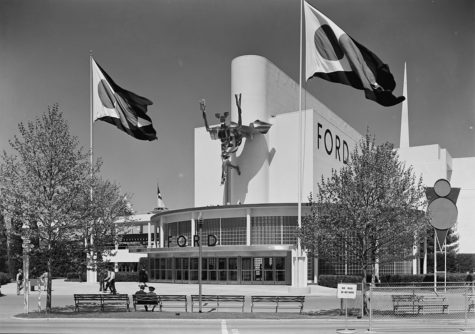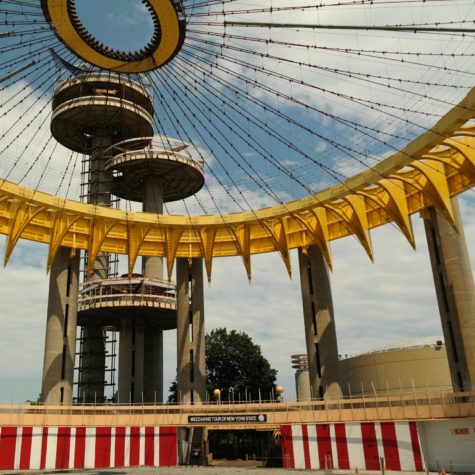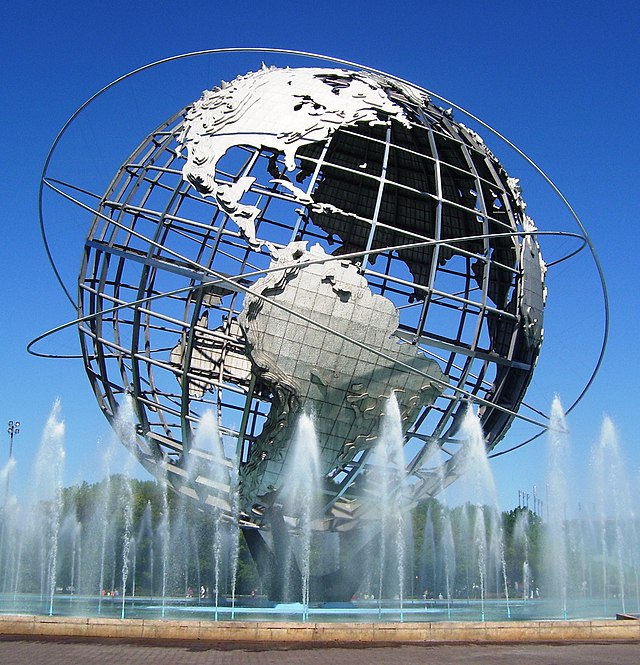A Glimpse of Corona Park from the 1900s to the Present
Flushing Meadows, Corona Park, in Queens, is the home of numerous cultural attractions such as the Unisphere and Citi Field. It had an unlikely origin as an ash dump during the early 1900s.
The Unisphere is one of the few structures that remained in the park following the end of the 1964 New York World’s Fair. Today, the Unisphere is still an iconic symbol of not only Corona Park, but also of the entire borough of Queens. (Photo Credit: Beyond My Ken, CC BY-SA 4.0
Flushing Meadows, Corona Park, is the largest park in Queens, with nearly 900 acres of land. Containing everything from a science museum to a skating rink, the park offers something for everyone, no matter the time of the year.
Today, you can pay a short visit to the park and see a variety of sights: picnics, basketball games, cherry blossoms, and more. The liveliness and endless options of activities is what makes the park so alluring to residents in Queens.
The land containing Corona Park has been used since the 1900s, but its original purpose was drastically different from what we use the park for today.
Corona Ash Dump
In the early 1900s, contractor Michael Degnon planned for the land around Flushing Bay to be turned into an industrial port. Working alongside the New York City Department of Sanitation and the Brooklyn Ash Removal Company, Degnon began to fill the land with coal ash.
Although the plan of creating a port was never fulfilled due to the onset of World War I in 1917, the ash remained and continued to enter the land, giving the land the name “Corona Dump.” The site amassed a staggering 50 million cubic yards of ash during the 26-years. In The Great Gatsby, F. Scott Fitzgerald described the land as “a valley of ashes — a fantastic farm where ashes grow like wheat into ridges and hills and grotesque gardens.”
Residents were outraged by the horrible odors and smoke produced by the ash dumps. In 1923, they brought The Brooklyn Ash Removal Company to court for allowing the dumps to emit dense smoke, a violation of the sanitary code.
The urban sprawl of the 1920s inspired New York City Parks Commissioner Robert Moses to develop plans to turn Flushing Meadows into a large park. In 1935, Flushing Meadows Park was chosen to be the site of the 1939 World’s Fair.
Transforming the ash dump into a park was not an easy task as it involved leveling heaps of ash, rising as high as 90 feet. The $50-million operation required up to 450 men, each working three shifts a day. It was during this time that major highways were constructed, such as the Van Wyck Expressway, the Long Island Expressway, and the Grand Central Parkway.
By 1939, the site had become a suitable park to host the World Fair.
1939 New York World’s Fair
The 1939 World’s Fair was held at Corona Park, and iot was intended to give visitors a glimpse into ‘The World of Tomorrow.’ For the 40 million people who attended, the exposition gave them hope amidst the chaos they were facing due to the Great Depression and the looming threat of America’s entrance into World War II.
The General Motors Exhibit displayed Futurama, a model city of 1960, a perfect representation of the fair’s utopian view of America’s future.

Other exhibits at the fair showcased a variety of new inventions, including the first television broadcast, aired by the Radio Corporation of America, and the first video game, displayed by Westinghouse Electric Corporation.
The most popular exhibits were the modernistic structures Trylon and Perisphere. They served as the focal point of the fair, visual representations of ‘The World of Tomorrow.’ Inside the 180 feet tall Perisphere, fairgoers observed Democracity, a diorama of the “city of the future.”
However, amidst the optimism and hope provided by the fair’s exhibitions, the threat of World War II became more clear as the fair progressed. Although America did not enter the war until 1941, the outbreak of World War II had consequences on participating nations, including Poland and Czechoslovakia, as they did not return for the 1940 season of the fair after being invaded by Germany.
The fair tried to push for more playful attractions to distract visitors from the harsh reality of the world, but the war, combined with labor unrest and financial failure, contributed to the fair’s closing in 1940.
Nevertheless, the fair remained a pivotal aspect in both Corona Park’s transformation and in American Culture.
1964 New York World’s Fair
In 1959, Flushing Meadows Park was once again chosen to host another World Fair. The theme of the 1964 World Fair was “Peace Through Understanding,” symbolized by the creation of the Unisphere, a 140 feet high steel model of the Earth. The Unisphere, according to the fair’s president, Robert Moses, “illustrates, symbolizes, and embodies man’s achievements on a shrinking globe in an expanding universe.”
Similar to the 1939 World’s Fair, the 1964 Fair showcased American industry and technology. The futuristic theme of the fair represented the emergence of the Space Age and Atomic Age.
140 pavilions were held in this World Fair, showcasing iconic American companies and also the cultures of countries around the world. The New York State Pavilion consisted of the Tent of Tomorrow, three Observation Towers, and a Theaterama. Measuring 350 feet by 250 feet, the Tent of Tomorrow had a terrazzo mosaic map of New York. The three Observation Towers allowed visitors to take “Sky Streak” elevators, which lined the sides of towers, to observation decks that were up to 200 feet high. Finally, the Theaterama showcased artwork by Andy Warhol and Roy Lichtenstein.

It was during this fair that the New York Hall of Science was constructed, making it one out of only a dozen science museums at the time. The museum showcased the American fascination with space during the Cold War space race. The two capsules displayed outside the museum, Mercury and Gemini, are remnants of the various missions of human space exploration that took place in the 1960s.
Even after the fair ended, the museum remained open for high school students to attend lessons on biology, physics, and mathematics, taught by instructors from New York City high schools, including the founder of Bronx Science, Dr. Morris Meister.
Interestingly, Terrace on the Park, the site of this year’s Junior Prom at Bronx Science, was also built for this World Fair. However, rather than a banquet hall, the terrace originally served as a heliport for helicopters arriving in New York.
The 1964 World Fair met a similar fate as the 1939 World Fair, failing to attract the expected number of visitors, ultimately ended with financial failure . The 50 million visitors were underwhelming compared to the anticipated 70 million visitors, and by the end of 1964, the World Fair had a deficit of $17.5 million.
Despite the financial failures, several establishments that were created during this fair, such as the Unisphere and New York Hall of Science, remain popular attractions today.
Post World’s Fairs
In 1987, the New York City Department of Parks and Recreation announced an $80 million 10-year restoration of the park. The project included replacing the roads and paths built for the past World Fairs with grass and landscaping the area around the Unisphere and the two surrounding lakes, Willow and Meadow Lake.
In 1997, the Arthur Ashe Stadium was built. With a seating capacity of 23,771, the stadium was the largest tennis arena in the world. The stadium is most commonly known for being used as the main court for the annual U.S. Open Tennis Championships, but it has also hosted various sports events, such as the first outdoor regular season WNBA game in 2008 and All Elite Wrestling in 2021. Arthur Ashe Stadium also served as the graduation venue for Bronx Science’s Class of 2021 and Class of 2022 (an outdoor venue was necessary during both years, due to the Coronavirus pandemic).
In 2008, The Flushing Meadows Natatorium opened. As the largest recreation complex ever built in a New York City park, the natatorium contains an Olympic-sized pool and an indoor ice rink.
A year later, Citi Field opened up as a replacement for the 1964 Shea Stadium, serving as the ballpark for the New York Mets. Although Citi Field has over 15,000 fewer seats than Shea Stadium, it has been praised for its wide variety of concession stands, its rotunda dedicated to Jackie Robinson, and its seat arrangement, designed specifically for baseball.
Today, over 9 million people visit Corona Park every year. With its wide array of cultural attractions and beautiful natural scenery, the park has come a long way from the ash dump that it once was.
The Unisphere, according to the fair’s president, Robert Moses, “illustrates, symbolizes, and embodies man’s achievements on a shrinking globe in an expanding universe.”
Grace Mao is a Managing Editor for 'The Science Survey,' where she edits her peers’ articles across various sections before they are published online....











